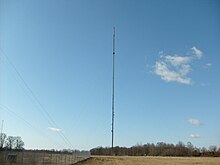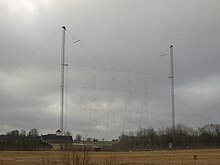Hörby station
The Hörby transmitter has existed since 1937. Initially, it was broadcast from there on medium wave 1,178 kHz. It was Sweden's only commercial radio station that also broadcast on shortwave frequencies. The shortwave was mainly used for broadcasting the international program of Sveriges Radio to inform Swedes abroad. Since 1959, programs for VHF and television broadcasting have also been broadcast.
history
Choice of location
The Hörby location was chosen for the medium and short wave transmitters so that they were as far away as possible from the annoying northern lights and as close as possible to the continent.
Medium wave
The first Hörby transmitter was a small 10 kW transmitter in Karlsfalts, a few kilometers from today's premises. It had been in operation since 1928 until 1937 the premises in Östra Sallerup, about 8 km south of Hörby, were completed with a new 100 kW medium wave transmitter from Telefunken. A guyed 130 m high steel lattice mast served as the antenna at the new location. The transmitter had to stay in operation until 1947 because it was difficult to get new tubes and other spare parts during the war. A new 100 kW transmitter could only be ordered and installed from Standard Electric & Cables Ltd in Great Britain after the war. This transmitter had to be kept in operation with considerable effort in its last years, until finally in 1985 the medium wave transmitter Sölvesborg could be put into operation on 1,179 kHz with 600 kW. The transmitter in Hörby was scrapped immediately after the shutdown. The transmitter mast was blown up and scrapped in the spring of 1985. The old transmitter from 1937, which was kept as a reserve until then, can now be seen in the Königs Wusterhausen transmitter museum .
Shortwave
Since July 1, 1938, there have been regular test broadcasts on Wednesday and Saturday evenings. The broadcasts in German over shortwave (6,065 kHz, 49 m) did not officially begin until May 8, 1952, when they were also broadcast by the longwave transmitter Motala . In the late 1960s, two new shortwave transmitters were ordered from Thomson , which were installed in the early 1970s. They replaced the two Marconi transmitters from the late 1940s, which were already slightly used when they were bought. The efficiency of the old transmitters was only about 50%. After 20 years of operation they were taken out of service because the high-voltage oil capacitors contained polychlorinated biphenyls . Officially they were scrapped, but were actually used as replacement transmitters, one in the shortwave station of the Norwegian state broadcaster NRK in Fredrikstad and the other in Gambia. In 1992 three more efficient shortwave transmitters ( PDM- modulated) with 500 kW from the manufacturer Thales Swiss were installed. They could be used for frequencies between 5,800 and 21,600 kHz.
Antennas
The antenna park consisted of nine curtain antennas in the directions 70, 150, 190, 250 and 290 degrees and two logarithmic-periodic antennas that could be rotated between 0 and 360 degrees. One was located next to the southern curtain antenna G1 on a 60 m high half-timbered mast, which however fell over in 1999 during a winter storm. This antenna was not rebuilt. The station was manned during office hours and was remotely controlled the rest of the time. The medium wave transmitter in Sölvesborg was also remotely controlled from Hörby. All shortwave broadcasts from Sweden ended on October 31, 2010. At the beginning of April 2011, the antenna park was completely demolished as it was considered hopeless to find a new tenant who could replace Radio Sweden. The shortwave transmitters were bought by Radio Nederland Wereldomroep , RNW, and installed in the spring of 2011 for a new life for 5 to 6 years at the RNW transmitter site in Madagascar.
Todays use
Various VHF and TV radio programs are now broadcast from the Hörby station. As early as 1959, a 323 m high guyed steel truss mast was erected as an antenna carrier for this purpose. When it was inaugurated on October 1, 1959, the mast was one of the tallest structures in Europe. In addition to various directional radio antennas, it mainly carries the antennas for VHF and television broadcasting. The VHF broadcasts can be received in neighboring Denmark as well as partially in Germany, namely on the island of Rügen and in the northern rest of Mecklenburg-Western Pomerania.
Analogue FM radio
| Broadcaster | Content (as of July 2012) | Area / channel |
ERP power (kW) |
|---|---|---|---|
| SR P1 | VHF radio, national program | FM 88.8 | 60 |
| SR P4 | VHF radio, regional, Radio Malmöhus | FM 89.5 | 5 |
| SR P2 | VHF radio, regional, P2 Riks | FM 92.4 | 60 |
| SR P3 | VHF radio, national program | FM 97.0 | 60 |
| SR P4 | VHF radio, regional, Radio Kristianstad | FM 101.4 | 60 |
Television broadcasting before the switch to DVB-T
Channel area |
Frequency (MHz) |
program | ERP (kW) |
Beam direction round (ND) / directional (D) |
Polarization horizontal (H) / vertical (V) |
|---|---|---|---|---|---|
| UHF 33 | 567.25 | SVT 2 (Malmo) | 1000 | ND | H |
| UHF 43 | 647.25 | SVT 1 | 1000 | ND | H |
| UHF 50 | 703.25 | TV4 (Malmo) | 1000 | ND | H |
Total channel occupancy after switching to DVB-T / DVB-T2
| Sender / MUX |
Content (as of July 2012) | Frequency / channel |
|---|---|---|
| SR P1 | VHF radio, national program | 88.8 MHz |
| SR P4 | VHF radio, Radio Malmöhus | 89.5 MHz |
| SR P2 | VHF radio, P2 Riks | 92.4 MHz |
| SR P3 | VHF radio, national program | 97.0 MHz |
| SR P4 | VHF radio, Radio Kristianstad | 101.4 MHz |
| MUX 1 | SVT and UR (with south network and west network) | UHF 33 |
| MUX 2 | TV4 channels (with TV4 Malmö and TV7 Malmö), TV6, CNN | UHF 43 |
| MUX 3 | TV3, Kanal 5, TV8, Disney channel, Canal + and others | UHF 41 |
| MUX 4 | Eurosport, Discovery, MTV, and others | UHF 25 |
| MUX 5 | TCM, Animal Planet, BBC World News, Silver, TV4 Sport and others | UHF 22 |
| MUX 6 | SVT1 HD, SVT2 HD (Südnetz), TV3 HD, TV4 HD (TV4 Malmö), Kanal 5 HD | UHF 30 |
| MUX 7 | BBC Entertainment, Canal + HD, MTV HD, National Geographic channel HD | VHF 10 |
Mux 1-5 send in DVB-T and Mux 6 + 7 send in DVB-T2.
Mux 7 transmits in the VHF range because there are no more UHF channels available at the Hörby location.
Web links
- Pictures from 2016: Antenna mounts for VHF and television broadcasting in Hörby
Sveriges Radio: Radio Sweden, the identifiers for broadcasts in German on shortwave. December 9, 2014, accessed May 30, 2019 .
Videos of the demolition of the antennas on April 2nd, 2011
apholmstedt: Video 1: Abbruch der Log-Per Antenne bei Hörby-Radio 2011. In: YouTube. 5. April 2011, abgerufen am 29. Mai 2019. apholmstedt: Video 2: Abbruch der Vorhangantennen bei Hörby-Radio 2011. In: YouTube. 5. April 2011, abgerufen am 29. Mai 2019. apholmstedt: Video 3: Abbruch der Vorhangantennen bei Hörby-Radio 2011. In: YouTube. 5. April 2011, abgerufen am 29. Mai 2019. apholmstedt: Video 4: Abbruch der Vorhangantennen bei Hörby-Radio 2011. In: YouTube. 5. April 2011, abgerufen am 29. Mai 2019. apholmstedt: Video 5: Abbruch der Vorhangantennen bei Hörby-Radio 2011. In: YouTube. 5. April 2011, abgerufen am 29. Mai 2019. apholmstedt: Video 6: Abbruch der Vorhangantennen bei Hörby-Radio 2011. In: YouTube. 5. April 2011, abgerufen am 29. Mai 2019.
Individual evidence
- ^ Radio Sweden: End of the short wave era. October 29, 2010, accessed May 28, 2019 .
- ↑ Radio Journal: Radio Sweden in German. December 1998, accessed May 28, 2019 .
- ↑ Hörby transmitter: LogPer antenna on a lattice mast at 60 m. October 1998, accessed May 28, 2019 .
- ^ Sveriges Radio: Radio Sweden will stop its shortwave broadcasts on October 31, 2010. March 10, 2010, accessed May 28, 2019 .
- ↑ Andy Sennitt: RNW brings short-wave transmitters from Hörby to Madagascar. April 28, 2011, archived from the original on October 17, 2011 ; accessed on May 28, 2019 (English).
Coordinates: 55 ° 48 ′ 22 ″ N , 13 ° 43 ′ 16 ″ E



